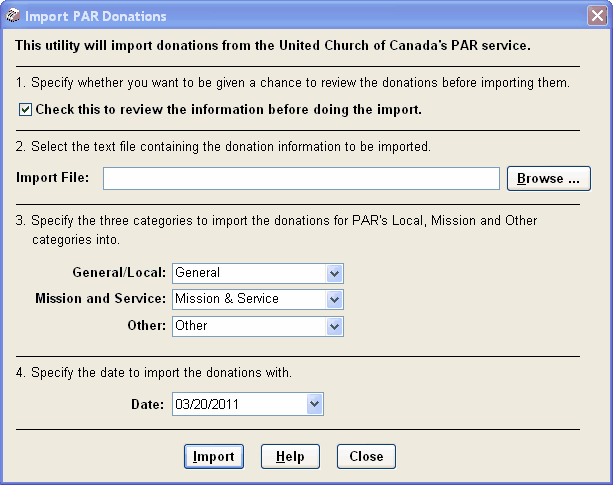The Database ⇒ Import ⇒ PAR Donations menu option allows you to import data files with donation information from the United Church of Canada's PAR (Pre-Authorized Remittance) service. If your church or organization is not using this specific PAR service, this menu option will be of no interest to you.
If you are not using the PAR service, or wish to import donations from another source or have other recurring donations set up in a different way, you have two other options:
1.Use the Database ⇒ Import ⇒ Donations menu option, which can handle recurring monthly donations.
2.Memorize and set up automatic weekly or monthly recurring donations.
When you select the Database ⇒ Import ⇒ PAR Donations menu option, the following window will come up:

Please note that this process will only work if you have informed the PAR service of the envelope numbers of all donors making PAR donations, because those envelope numbers have to be used to match up the donors in the PAR file with your donors in DONATION. In addition, you have to specifically request that they send you the importable text file monthly, not just the formatted PDF report that they normally send.
In section 1 of this window, you can select whether or not you wish to review the donations to be imported, before the import is completed. This is strongly recommended, because it allows you to see the names of the donors, along with the envelope numbers. (Only envelope numbers are included in the import file.)
In section 2, you specify the name of the file to be imported. This is the text file (not the PDF file!) that the PAR service will provide to you monthly, if you have requested it, containing the details of all PAR donations for the month. It is sent as an email attachment, which you will have to save to a folder where you can find it. One suggestion is to save it in DONATION's Data Directory, because that is where the Browse button looks by default.
In section 3, you specify the three DONATION categories that correspond to the three categories your PAR donors can select to donate to: Local/General, Mission and Service, and Other. The first time you use this, DONATION will try to guess the best match for these categories by name, but if it doesn't guess correctly, you can change the settings. These settings are memorized for you, from month to month.
In section 4, you select the month whose data you are importing. As we understand it, the PAR donations are always processed on the 20th of the month (or the next business day, if the 20th isn't a business day). So, only 20ths of the month are shown as possible dates. Normally you would accept the default setting here, for the current (or most recent) month, but if you are behind in your work, you might need to select an earlier month from the drop-down list, which goes backwards from the current month to January of the current year.
Once you have selected all of these settings, click Import to start the import process. The first thing it does is check the data file for any problems. If there are problems, it will tell you what they are, and cancel the import process. If everything is OK, what happens next depends on the setting in the "Check this to review the information before doing the import" checkbox.
If the checkbox in section 1 is checked, you are first shown the donations to be imported, with each donor's name. If the donor is donating in multiple categories, there will be one donation row for each of those categories. If everything looks OK, click the Import button on the preview window to complete the import.
If the checkbox is not checked, the import is done immediately.
Of course, you can also click Close in this window if you want to abandon the import, or Help to see this help page.
Format of the PAR Import File
The file names are things like 12345678_Jan-21-15.txt. That's a file from January 21, 2015. we think the numbers at the start of the file's name may identify your organization's account with PAR.
The file consists of lines like:
501 1909973 325.00 15.00 0.00
The first 10 character positions (at the right end of which you see "501" in the same line above) are the donor's envelope number, which determines which donor the donations on that line get imported into. The next 10 character positions (with "1909973" in them in this example) are ignored by DONATION, and we are not sure what they are, perhaps some sort of internal donor numbers that PAR uses. The next three sections are the three dollar amounts for the donor's donations that month to what PAR considers to be General/Local, Mission and Service, and Other, respectively, which you allocated to your own donation categories in the window shown above. Values of 0.00 are of course ignored when importing them.
This topic was last edited on Mar 23, 2023